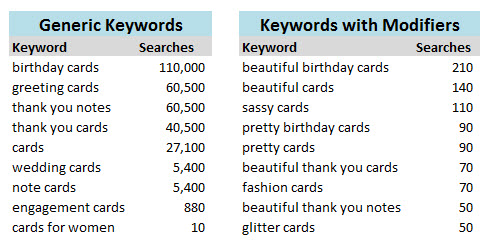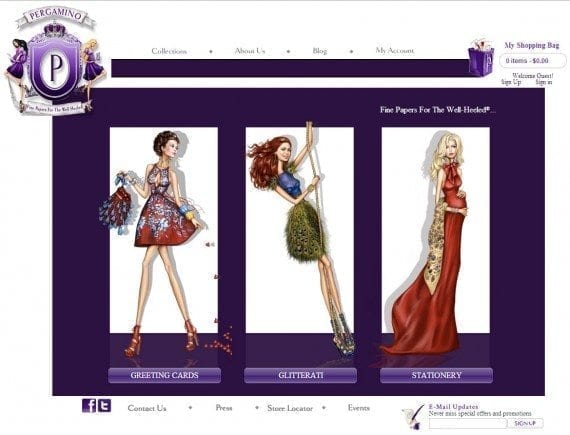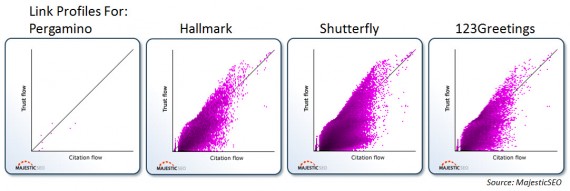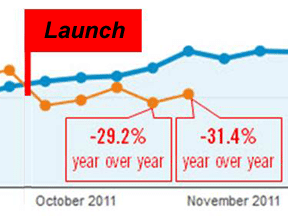Fashion-oriented stationer Pergamino has an organic search traffic problem – there’s not enough of it. Founder and Chief Creative Officer Monica Luburich reached out for an SEO review to find out how to improve her site’s organic search performance.
Luburich’s challenge with organic search as an entrepreneur creating and selling high-fashion greeting cards online is not unusual. Her strength lies in her creativity, as well as her background in business and fashion. As a reflection of those strengths and the highly visual nature of her product, the ecommerce site is heavy on product imagery and light on textual content in the places that really matter.
As with all ecommerce sites, in order to drive organic search traffic and sales Pergamino needs to send keyword signals for popular search phrases. The strength of those keyword signals needs to also be amplified and verified by earning links from other sites across the Internet.
This single article can’t recommend every optimization required for a site, but a focus on keywords and links is foundational to any site’s success.
Keyword Choices
First and foremost, Pergamino sells greeting cards and note cards. These are special greeting cards, “tastefully hand-glittered greeting cards are printed with eco-friendly inks on luxe, recycled paper” with a “cashmere-soft texture.” But when customers search for the product that Pergamino sells they search for “greeting cards.” Consequently, if Pergamino wants to attract organic search visits and convert them to sales, the site will have to begin researching the words people use to search for their products and incorporating these keyword phrases into the site strategically.

Niche keywords, at right, have less SEO competition.
For example, Pergamino is relevant to phrases like “birthday cards,” “thank you notes,” and “note cards.” Not surprisingly, the chart above shows that these are highly searched phrases. They’re also highly competitive. Major e-card and ecommerce sites like 123Greetings, Shutterfly, Zazzle and Hallmark rank on page one in Google for “birthday cards.” Even handcrafted greeting card brand Papyrus isn’t listed on page one. A boutique site like Pergamino would be hard pressed to quickly compete in that keyword market. Over time, with the right focus and dedication, anything is possible.
More niche keyword phrases typically generate less competition, as well as fewer searches. Searchers are not searching for the precise product Pergamino sells — “illustrated fashion birthday cards” — unfortunately. Research shows that searchers do query Google for modifiers like “beautiful,” “sassy,” “pretty,” and “glitter” in association with greeting card phrases. Further keyword research would hopefully result in additional modifiers and niches of greeting card keywords that Pergamino can target successfully with SEO. I’ve addressed keyword research previously, at “Optimizing a Page for Search Engines, Part 1: Keyword Research.”
Using Keywords in the Content
Once the keywords have been defined, they need to be applied strategically to the relevant pages. The most important elements on each page for SEO are the title tag and descriptive content. Pergamino uses the same title tag on each page: “Pergamino.” This wastes a valuable opportunity to tell search engines in approximately 65 characters what the page should rank for.
For example, the home page might target “greeting cards” and “sassy cards.” The title tag could read something like this: “Pergamino Greeting Cards: Sassy Cards Celebrating Beautiful Women.” I’d normally end with the brand instead of leading with it, but Pergamino needs to build brand recognition as well as organic search visibility.
The next step is incorporating the keywords into the descriptive content on the page. Actually, before Pergamino can do that, it needs to add space into the template to accept textual content. The same is true of the category pages as well.

Pergamino home page.
The only keywords that appear on the home page are the “Greeting Cards” and “Stationery” buttons that link to the product category pages. Each of these buttons could also be tagged with H2 headings to emphasize their importance slightly to the search engines.
The tagline “Fine Papers For The Well-Heeled…” is not a long enough piece of text, nor does it contain any phrases that searchers would search for. Perhaps the tagline area could be expanded to accept two sentences of copy that contain the keywords chosen for the title tag. Or perhaps the size of the three primary images could be reduced to make room for descriptive text beneath them.
On each page, the body content should describe that page’s product offering for customers and use the targeted keywords at least once. If the copy is short, don’t try to work in repetitions of the keyword phrases or the result will be spammy for search engines and unpleasant for customers.
Lead the copy block off with a descriptive headline coded as an H1 heading. On the home page the H1 heading could simply be “Pergamino Greeting Cards.”
On product pages, the amount of copy is sufficient for SEO, but every product in the same category shares the same product description. Only the inscription inside the card and horoscope description, if there is one, is unique to each product. In order for the individual cards to rank, they need to target unique keywords with unique title tags, body content and headings.
Link Authority
Lastly, and most importantly, Pergamino suffers from a lack of link authority. Google Webmaster Tools shows less than 1,000 links in its link profile. For a site competing with the likes of Hallmark, Shutterfly and 123Greetings, 1,000 inbound links is a drop in the bucket.

These scattter graphs show link authority passing from in-bound links. More pink is better.
The chart above visualizes the link profiles for these four sites. The pink splatter graphs show the amount of authority passed by other sites to the site shown. More pink is better, and pink closer to the upper right corner is better.
Often, sites with widely recognized brand names and long histories boast stronger link profiles. These sites are difficult to compete against in organic search as a result, particularly for boutique shops with a very niche product offering.
Pergamino has been featured in a handful of blogs like Opulent Creations Events and Why Not Girl. These posts appear to be the result of connections made at industry shows and in the course of business. This is a great start to earning link authority. The most recent ones seem to be aging rapidly, though. A continued focus on leveraging connections for the publicity and link authority they can generate will be very beneficial.
Pergamino also has a nice start on Pinterest. While Pinterest isn’t going to provide a ton of SEO value, Pergamino has had some success there. Google attributes over half of Pergamino’s backlinks to Pinterest. While these may not pass actual link authority, they are clearly visible to Google and may count as social signals somewhere in Google’s algorithm.
Even without direct SEO value, Pergamino should continue to capitalize on its Pinterest successes by reaching out to pinning fans and continuing to post a diverse selection of Pins alongside its product Pins. (For more, see “Does Pinterest Help with SEO.”) Pergamino should also consider linking to its Pinterest profile from its site in the same way it links to its Facebook and Twitter profiles. Adding Pinterest and Twitter sharing widgets to the product pages alongside the Facebook widget is another excellent way to encourage visitors to share. While all this social activity won’t directly boost link authority — because the links are purposely stripped of SEO value — social activity gets the brand and product in front of more eyeballs. Some of those shares will turn into blog posts and links as well as reshares, site visits and sales.





